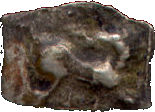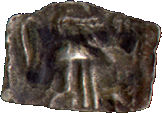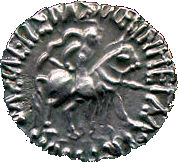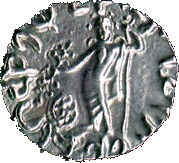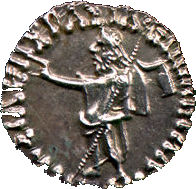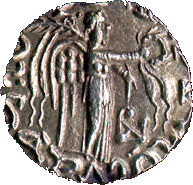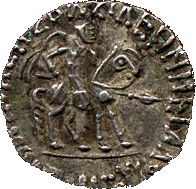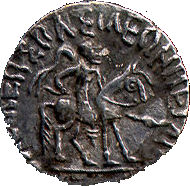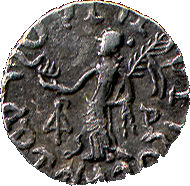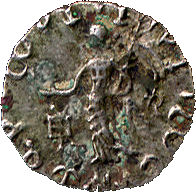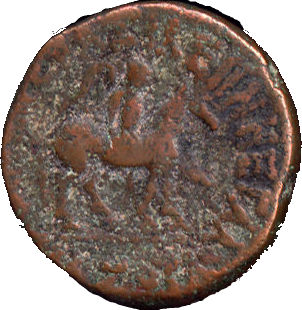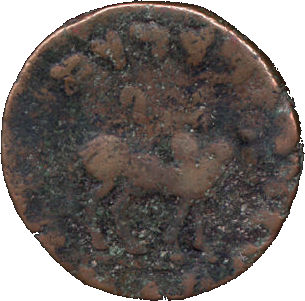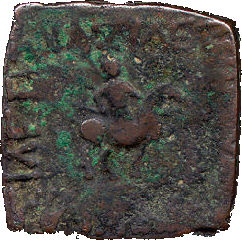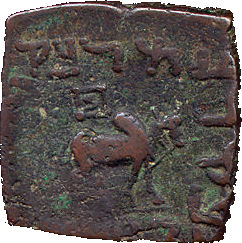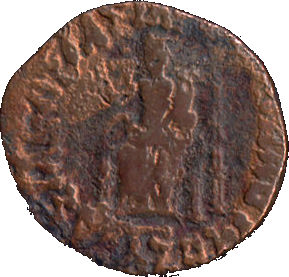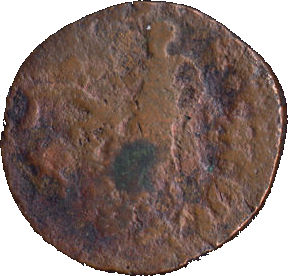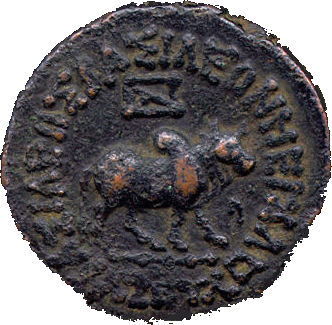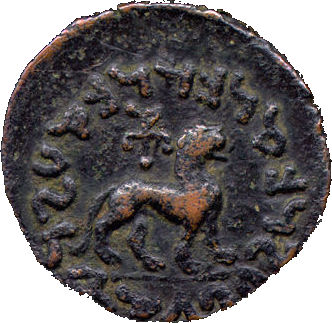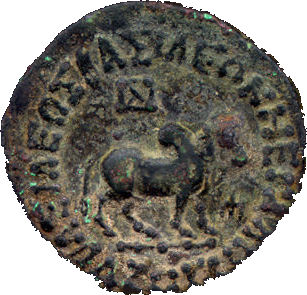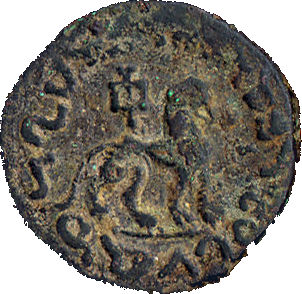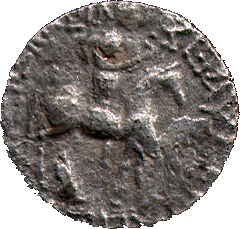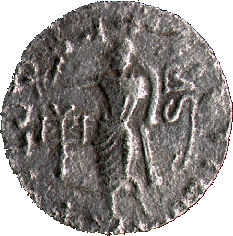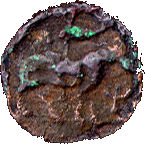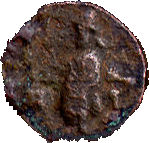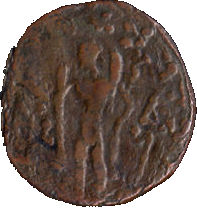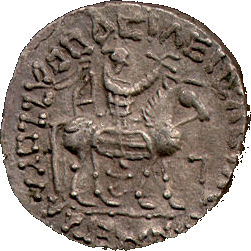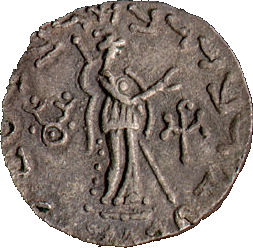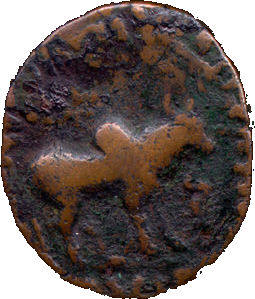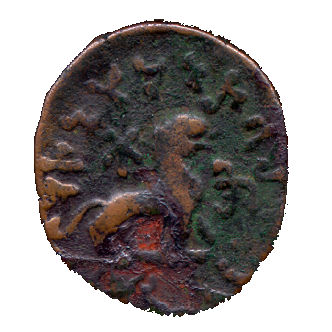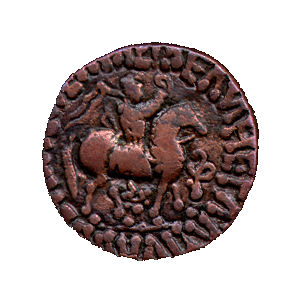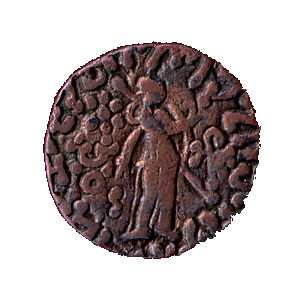Russian page needs a translation
INDO-SCYTHIAN COINS
INTRODUCTION
The Indo-Scythian coins and Turanian coins are related. They share a common alphabet, called Karosthi or Kharosthi Script in India and Turanian alphabet in Turan/Sogdiana.
The Turanian coin legends of the 2-nd c. BC - 8-th c. AD period are studied in the work of Azgar Mukhamadiev Turanian Writing. The detailed study has images, tracings, transliterations and translations, but it is not intended to give a substantial historical background with the dynastic lineages and the dynamic development of the events.
The http://indoeuro.bizland.com/project/script/kharo.html gives a brief description of the Karosthi alphabet. Believed to be initiated from the Aramaic script by the Achaemenid Indic satrapies’ scribes (Andrew Glass http://depts.washington.edu/ebmp/downloads/Glass_2000.pdf ), the name is thought to originate from the Chinese unkindly reference to the right-to left script as an “ass-lip”. Karosthi is a syllabary, with consonant basic signs and vowels denoted, with the exception of an “a”, by additional symbols next to the consonant.
The first known inscription in Karosthi was found in Pakistan and dates to 251 BC. Different sources give an earlier initial date. Coins with legends in Karosthi were found from almost all chronological span of the script, including issues of the Indo-Greeks, Indo-Scythians, Indo-Parthians, Kushans, Satrapies, Audumbaras, Kulutas, Kunindas, Rajanyas, Vemakis and Vrsnis. Many of these coins were catalogued and illustrated in Gardner 1886, Hill 1906, Smith 1906, Rapson 1908, Whitehead 1914, and Allan 1936. Sino-Karosthi coins, bearing inscriptions in both Chinese and Karosthi, were found near Khotan. The illustrations, attributions, and dates are in Cribb 1984, 1985.
From the 4-th century BC until the 3-rd century AD, the area underwent a number of divisions and transformations, it was controlled by the Western and Eastern overlords, and experienced a variety of cultural invasions. The use of Karosthi was contemporary with Brahmi alphabet, and both systems were used in the area for several centuries, with Karosthi used in the Hunnic west and northwest of India, and Brahmi more suitably used for the non-Türkic, Indic languages in the southeast of India. Karosthi is written from right to left, and, with the cultural impacts of the dominating powers, the Indic speakers use Brahmi, which reads from the left. Over time, other scripts gradually replaced Karosthi. The Karosthi script disappeared completely by the 6th century AD.
Karosthi is found in the Türkic settlement area: present Afghanistan, Central Asia, northeast China, Bactria, Pakistan, and the Scythian area in India.
For the Indo-Scythian coins, the images, tracings, transliterations, and translations will also be available at sometime. The combined alphabet table gives a cross-reference for the Karosthi and Turanian letter graphemes. A common thread is clearly visible, in spite of the different orientation of the letters given in the sources. The strong similarity in the graphemes of the two alphabets reflects a common source in their development, and leaves a room to ponder about the causes of the differences. In both cases, the initial issues of the coins are bilingual and follow the Greco-Bactrian models. The nomadic dignity is relayed by the mage of an armed rider, shown on the early antique Khoresmian coin of the2-1-st cc. BC Turanian period, during the time of the powerful Hunnish state.
Click to enlarge

CLICK TO REDUCE
Antique Khoresmian coin with an inscription "Turan Yabgu"
In the following
commercial for the ancient Indo-Scythian silver coins, in line with the best
guesses of the experts, the nomadic rider becomes a proverbial Zeus:
quote-unquote “…ancient silver coins
of the Indo-Scythians (i.e. the Asiatic horde noted for its battles with the ancient
Greeks). Dating back to 35 B.C., they're the first known example of bilingual
coinage (Greek and Scythian dialects). Obverse depicts Scythian King, Azes II
surrounded by an ancient legend, in Greek. Reverse features Zeus
(sic!) surrounded by Karosthi legend…”
(
http://secure.sovietski.com/cgi-bin/Sovietski.storefront/EN/Product/206383?AID=5521877&PID=889402)
Click to enlarge

CLICK TO REDUCE
In most cases I have a record where the page came from. It is possible that the source site moved or does not exist any more. All pages are accessible from their original source, and no credit is clamed here. Commercial use of these materials may not be made without written permission. The major source is the http://www.grifterrec.com/coins/indoscythian/indoscythian.html. The coins are mirrored here because they provide a factual information on the common historical background and cultural affinity, essential for the understanding of the ongoing speculations on the linguistic affiliations.
Karosthi (Kharoshthi) alphabet: http://www.omniglot.com/writing/kharosthi.htm.
Transliteration and translation of legends: They say it is Karosthi, but nobody has read it in Karosthi. I would love to see it. Please let me know if you have it.
http://www.grifterrec.com/coins/indoscythian/indoscythian.html
i n d o - s c y t h i a n s
About Indo-Scythians.
Scythian Kingdom in Arachosia |
|
|
Early anepigraphic coinage (circa 110 - 100 BC) |
|
|
Click to enlarge |
Click to enlarge |
|
Vonones (circa 100 - 65 BC) |
|
|
Click to enlarge |
Click to enlarge |
Scythian Kingdom in PakistanAzes I and Azes II might be the same king. |
|
| Azes I | |
|
Azes I (57 - 35 BC) |
|
|
Click to enlarge |
Click to enlarge |
|
Azes I (57 -
35 BC) |
|
|
Click to enlarge Click to enlarge |
Click to enlarge Click to enlarge |
|
Azes I (57 - 35 BC) |
|
|
Click to enlarge |
Click to enlarge |
|
Azes I (57 - 35 BC) |
|
|
Click to enlarge |
Click to enlarge |
| Azilises | |
|
Azilises I (57 - 35 BC) |
|
|
Click to enlarge |
Click to enlarge |
| Azes II | |
|
Azes II (35 BC - 5 AD) |
|
|
Click to enlarge |
Click to enlarge |
|
Azes II (35
BC - 5 AD) |
|
|
Click to enlarge |
Click to enlarge |
|
Azes II (35 BC - 5 AD) |
|
|
Click to enlarge |
Click to enlarge |
|
Azes II (35 BC - 5 AD) |
|
|
Click to enlarge |
Click to enlarge |
|
Azes II (35 BC - 5
AD) |
|
|
Click to enlarge |
Click to enlarge |
|
Azes II (35 BC - 5 AD) |
|
Click to enlarge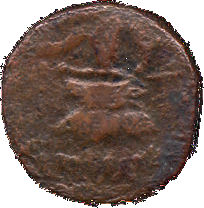 CLICK TO REDUCE Obverse: King seated cross-legged, facing. Greek legend. |
Click to enlarge |
|
Azes II (35 BC - 5 AD) |
|
|
Click to enlarge |
Click to enlarge |
Age of the Satraps |
|
|
Zeionises, son of Manigula (circa 23 AD) |
|
|
Click to enlarge |
Click to enlarge |
|
Aspavarma (5 - 35 AD) |
|
|
Click to enlarge |
Click to enlarge |
| b a c k t o a n c i e n t c o i n s | |
| if i've made a mistake or if you have a comment you can drop me a line at tkmallon-mccorgray@grifterrec.com |
|
